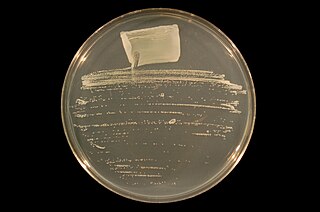
Ensifer meliloti are an aerobic, Gram-negative, and diazotrophic species of bacteria. S. meliloti are motile and possess a cluster of peritrichous flagella. S. meliloti fix atmospheric nitrogen into ammonia for their legume symbionts, such as alfalfa. S. meliloti forms a symbiotic relationship with legumes from the genera Medicago, Melilotus and Trigonella, including the model legume Medicago truncatula. This symbiosis promotes the development of a plant organ, termed a root nodule. Because soil often contains a limited amount of nitrogen for plant use, the symbiotic relationship between S. meliloti and their legume hosts has agricultural applications. These techniques reduce the need for inorganic nitrogenous fertilizers.

The Hyphomicrobiales are an order of Gram-negative Alphaproteobacteria.

Ensifer is a genus of nitrogen-fixing bacteria (rhizobia), three of which have been sequenced.
Ensifer fredii is a nitrogen fixing bacteria of the genus Sinorhizobium. It is a fast-growing root nodule bacteria. Sinorhizobium fredii exhibit a broad host-range and are able to nodulate both determinant hosts such as soy as well as indeterminate hosts including the pigeon pea. Because of their ease of host infection there is interest in their genetics and the symbiotic role in host infection and nodule formation.
Pararhizobium giardinii is a Gram negative root nodule bacteria. It forms nitrogen-fixing root nodules on legumes, being first isolated from those of Phaseolus vulgaris.
Rhizobium gallicum is a Gram-negative root-nodule bacterium. It forms nitrogen-fixing root nodules on legumes, being first isolated from those of Phaseolus vulgaris.
Bradyrhizobium arachidis is a species of legume-root nodulating, microsymbiotic nitrogen-fixing bacterium. It was first isolated from Arachis hypogaea root nodules in China. Its type strain is CCBAU 051107T.
Bradyrhizobium canariense is a species of legume-root nodulating, endosymbiont nitrogen-fixing bacterium. It is acid-tolerant and nodulates endemic genistoid legumes from the Canary Islands. The type strain is BTA-1T.
Mesorhizobium plurifarium is a species of root nodule bacteria first isolated from Acacia species in Senegal. Its type strain is ORS 1032.
Mesorhizobium amorphae is a species of root nodule bacteria first isolated from Amorpha fruticosa species in China. It is purported to be native to American soil. Its genome has been sequenced. Its type strain is ACCC 19665.
Bradyrhizobium yuanmingense is a species of legume-root nodulating, endosymbiont nitrogen-fixing bacterium, associated with Lespedeza and Vigna species. Its type strain is CCBAU 10071(T).
Neorhizobium huautlense is a Gram negative root nodule bacterium. It forms nitrogen-fixing root nodules on Sesbania herbacea.
Mesorhizobium mediterraneum is a bacterium from the genus Mesorhizobium, which was isolated from root nodule of the Chickpea in Spain. The species Rhizobium mediterraneum was subsequently transferred to Mesorhizobium mediterraneum. This species, along with many other closely related taxa, have been found to promote production of chickpea and other crops worldwide by forming symbiotic relationships.
Devosia neptuniae is a nitrogen-fixing bacteria that nodulates Neptunia natans. It is Gram-negative, strictly aerobic short rod-shaped and motile by a subpolar flagellum. The type strain of D. neptuniae is LMG 21357T.
Gluconacetobacter azotocaptans is a species of acetic acid bacteria first isolated from rhizospheres and rhizoplanes of coffee plants. Its type strain is CFN-Ca54T.
Rhizobium indigoferae is a Gram negative root nodule bacteria, which nodulates and forms nitrogen-fixing symbioses with Indigofera species Its type strain is CCBAU 71714(T).
Arcobacter ebronensis is a species of bacteria first recovered from mussels, with type strain F128-2T.
Arcobacter aquimarinus is a species of bacteria first recovered from mussels, with type strain W63T.

Ensifer numidicus is a gram-negative, aerobic, non-spore forming, rod-shaped bacterium of the family Rhizobiaceae. First described in 2010; more biovars have since been isolated and described with ORS 1407 considered the representative organism. Most examples have been found in arid and infra-arid regions of Tunisia.

Argyrolobium uniflorum is a wild pluriannual herbaceous species of drought tolerant legume found in arid regions of Northern Africa sometimes described as psuedo-savannah.




